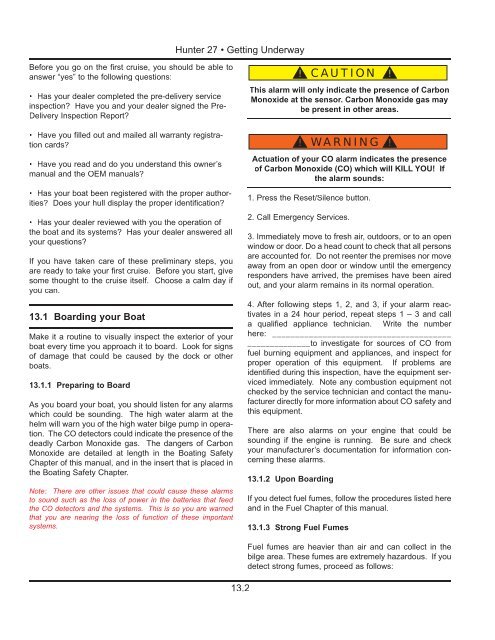27 Operator's Manual.. - Marlow-Hunter, LLC
27 Operator's Manual.. - Marlow-Hunter, LLC
27 Operator's Manual.. - Marlow-Hunter, LLC
You also want an ePaper? Increase the reach of your titles
YUMPU automatically turns print PDFs into web optimized ePapers that Google loves.
<strong>Hunter</strong> <strong>27</strong> • Getting Underway<br />
Before you go on the first cruise, you should be able to<br />
answer “yes” to the following questions:<br />
• Has your dealer completed the pre-delivery service<br />
inspection? Have you and your dealer signed the Pre-<br />
Delivery Inspection Report?<br />
• Have you filled out and mailed all warranty registration<br />
cards?<br />
• Have you read and do you understand this owner’s<br />
manual and the OEM manuals?<br />
• Has your boat been registered with the proper authorities?<br />
Does your hull display the proper identification?<br />
• Has your dealer reviewed with you the operation of<br />
the boat and its systems? Has your dealer answered all<br />
your questions?<br />
If you have taken care of these preliminary steps, you<br />
are ready to take your first cruise. Before you start, give<br />
some thought to the cruise itself. Choose a calm day if<br />
you can.<br />
13.1 Boarding your Boat<br />
Make it a routine to visually inspect the exterior of your<br />
boat every time you approach it to board. Look for signs<br />
of damage that could be caused by the dock or other<br />
boats.<br />
13.1.1 Preparing to Board<br />
As you board your boat, you should listen for any alarms<br />
which could be sounding. The high water alarm at the<br />
helm will warn you of the high water bilge pump in operation.<br />
The CO detectors could indicate the presence of the<br />
deadly Carbon Monoxide gas. The dangers of Carbon<br />
Monoxide are detailed at length in the Boating Safety<br />
Chapter of this manual, and in the insert that is placed in<br />
the Boating Safety Chapter.<br />
Note: There are other issues that could cause these alarms<br />
to sound such as the loss of power in the batteries that feed<br />
the CO detectors and the systems. This is so you are warned<br />
that you are nearing the loss of function of these important<br />
systems.<br />
! CAUTION !<br />
This alarm will only indicate the presence of Carbon<br />
Monoxide at the sensor. Carbon Monoxide gas may<br />
be present in other areas.<br />
! WARNING !<br />
Actuation of your CO alarm indicates the presence<br />
of Carbon Monoxide (CO) which will KILL YOU! If<br />
the alarm sounds:<br />
1. Press the Reset/Silence button.<br />
2. Call Emergency Services.<br />
3. Immediately move to fresh air, outdoors, or to an open<br />
window or door. Do a head count to check that all persons<br />
are accounted for. Do not reenter the premises nor move<br />
away from an open door or window until the emergency<br />
responders have arrived, the premises have been aired<br />
out, and your alarm remains in its normal operation.<br />
4. After following steps 1, 2, and 3, if your alarm reactivates<br />
in a 24 hour period, repeat steps 1 – 3 and call<br />
a qualified appliance technician. Write the number<br />
here: _______________________________________<br />
______________to investigate for sources of CO from<br />
fuel burning equipment and appliances, and inspect for<br />
proper operation of this equipment. If problems are<br />
identified during this inspection, have the equipment serviced<br />
immediately. Note any combustion equipment not<br />
checked by the service technician and contact the manufacturer<br />
directly for more information about CO safety and<br />
this equipment.<br />
There are also alarms on your engine that could be<br />
sounding if the engine is running. Be sure and check<br />
your manufacturer’s documentation for information concerning<br />
these alarms.<br />
13.1.2 Upon Boarding<br />
If you detect fuel fumes, follow the procedures listed here<br />
and in the Fuel Chapter of this manual.<br />
13.1.3 Strong Fuel Fumes<br />
13.2<br />
Fuel fumes are heavier than air and can collect in the<br />
bilge area. These fumes are extremely hazardous. If you<br />
detect strong fumes, proceed as follows:

















